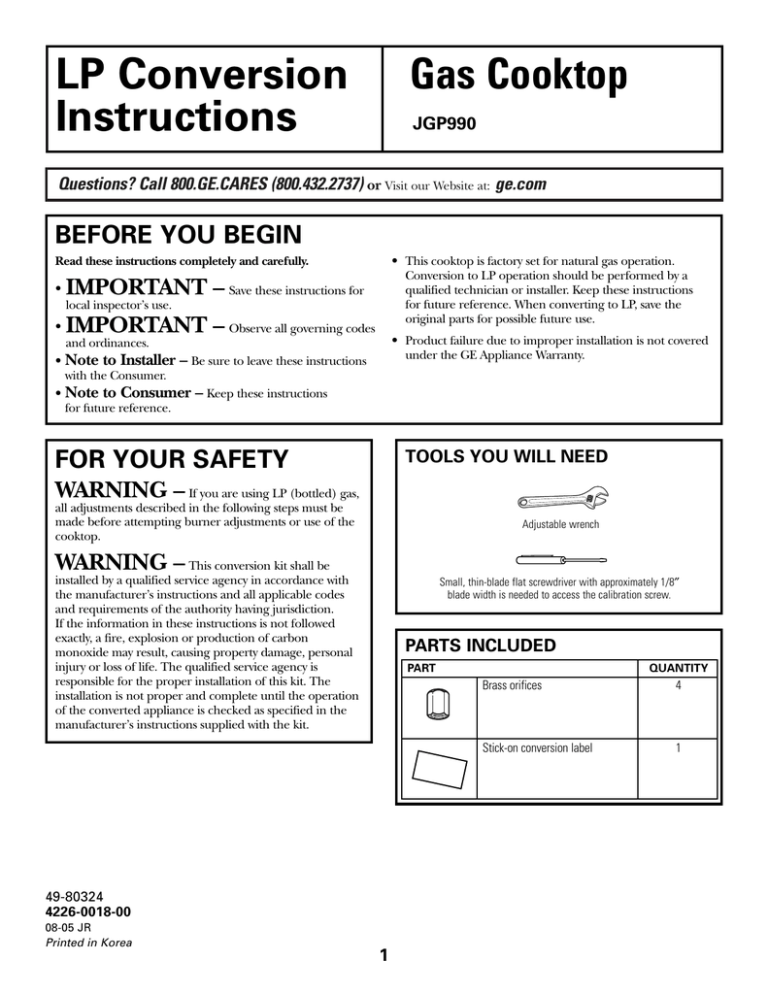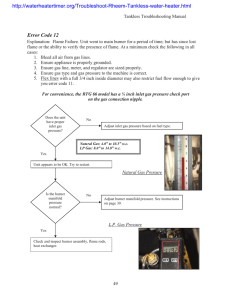LP Conversion Gas Cooktop Instructions
advertisement

LP Conversion Instructions Gas Cooktop JGP990 Questions? Call 800.GE.CARES (800.432.2737) or Visit our Website at: ge.com BEFORE YOU BEGIN • This cooktop is factory set for natural gas operation. Conversion to LP operation should be performed by a qualified technician or installer. Keep these instructions for future reference. When converting to LP, save the original parts for possible future use. Read these instructions completely and carefully. • IMPORTANT – Save these instructions for local inspector’s use. • IMPORTANT – Observe all governing codes • Product failure due to improper installation is not covered under the GE Appliance Warranty. and ordinances. • Note to Installer – Be sure to leave these instructions with the Consumer. • Note to Consumer – Keep these instructions for future reference. FOR YOUR SAFETY TOOLS YOU WILL NEED WARNING – If you are using LP (bottled) gas, all adjustments described in the following steps must be made before attempting burner adjustments or use of the cooktop. Adjustable wrench WARNING – This conversion kit shall be installed by a qualified service agency in accordance with the manufacturer’s instructions and all applicable codes and requirements of the authority having jurisdiction. If the information in these instructions is not followed exactly, a fire, explosion or production of carbon monoxide may result, causing property damage, personal injury or loss of life. The qualified service agency is responsible for the proper installation of this kit. The installation is not proper and complete until the operation of the converted appliance is checked as specified in the manufacturer’s instructions supplied with the kit. Small, thin-blade flat screwdriver with approximately 1/8″ blade width is needed to access the calibration screw. PARTS INCLUDED PART 49-80324 4226-0018-00 08-05 JR Printed in Korea 1 QUANTITY Brass orifices 4 Stick-on conversion label 1 LP Conversion Instructions GAS SUPPLY 1 CONVERT THE PRESSURE REGULATOR • With the installation of this conversion kit, the cooktop should operate on LP gas at 10″ of water column pressure. • The pressure regulator must be connected in series with the manifold of the cooktop and must remain in series with the supply line. For proper operation, the maximum inlet pressure to the regulator must be no more than 14″ water column pressure for LP gas. • When checking the regulator, the inlet pressure must be at least 1″ greater than the regulator output setting. If the regulator is set for 10″ of water column pressure, the inlet pressure must be at least 11.″ A Locate the pressure regulator under the front of the cooktop. B Remove the nut from the pressure regulator with an adjustable wrench. IMPORTANT – Disconnect the cooktop and the individual shut-off valve from the gas supply piping system during any pressure testing of that system at test pressures greater than 1/2 psig. Isolate the cooktop from the gas supply piping system by closing the individual manual shut-off valve to the cooktop during any pressure testing of the gas supply piping system at test pressures equal to or greater than 1/2 psig. Natural gas Nut TURN OFF GAS AND ELECTRIC SUPPLY LP gas BEFORE YOU BEGIN, TURN OFF THE GAS SUPPLY AT THE SHUT-OFF VALVE. DISCONNECT THE ELECTRICAL SUPPLY FROM THE COOKTOP. C Remove the plastic pin from the inside of the nut, turn the pin 180° and snap the pin back into the nut. Natural gas LP gas Nut Electrical supply Shut-off valve 2 D Re-install the nut onto the regulator. E Apply the LP Conversion label next to the Rating Plate. LP Conversion Instructions 2 CONVERT SURFACE BURNERS 3 ADJUST GRILL BURNER AIR SHUTTER Air shutter The air shutters for the grill burner may need to be adjusted to get better flame appearance and ignition. The air shutters for the grill burner are located on the bottom of the grill burner. To access the air shutters, remove the grill grate, and then the grill burner. Loosen the screw and slide the air shutter backward or forward to increase or decrease the size of the air opening. Re-tighten the screw. Turn clockwise to tighten Orifice Turn counterclockwise to remove A Remove all grates and burner modules. B With an adjustable wrench or an open end wrench, remove the brass orifices. C Find the inscribed LP orifices in the holder in the front of the electric cover beneath the cooktop. D Install the inscribed LP orifices in place of the natural gas orifices. E Replace the burner modules and grates. F Keep all the spuds with your cooktop so you have them if you move or get a different gas hook-up. Loosen screw Adjust air shutter opening Tighten screw 4 CHECK IGNITION A Connect electrical supply cord. B Turn on the gas; check for leaks using a liquid leak detector at all joints in the system. WARNING: DO NOT USE A FLAME TO CHECK FOR GAS LEAKS. Push in one control knob and turn to the LITE position. The igniter will spark and the burner will light. The first test may require some time while air is flushed out of the gas line. After ignition, turn the control knob to the HI position and wait until the flame settles. LP (Propane) Gas 10″ W.C.P. Burner Output Rating in BTU/HR Location BTUs Orifice Size Engraving Left Rear (LR) 9,100 .0354 LP Left Front (LF) 9,100 .0354 LP Right Rear (RR) 9,100 .0354 LP Right Front (RF) 9,100 .0354 LP C Check to determine if your burner flames are normal. If burner flames look like A, turn off the burner and make sure all parts are assembled correctly. Reassemble and check. Normal burner flames should look like B or C, depending on the type of gas you use. With LP gas, some yellow tipping on outer cones is normal. A–Yellow flames Not normal; check alignments 3 B–Yellow tips Normal for LP gas C–Soft blue flames Normal for natural gas D Turn the knob to OFF. E Repeat the procedure for each burner. LP Conversion Instructions 5 ADJUST THE LOW FLAME 5 ADJUST THE LOW FLAME (SIMMER) SETTING (cont.) (SIMMER) SETTING The top burner valves have low flame/simmer adjustment screws accessible through the valve switches. A flashlight may be needed to locate the screw. A small, thin-blade screwdriver (approximately 1/8″ blade width) is needed to access the screw. A Light two other burners and set the knobs to a medium to high setting. B Light the burner to be adjusted and turn the knob to LOW. C To make adjustment, remove the control knobs. Insert a screwdriver through the access hole in the valve switch. Engage the adjustment screw in the valve. F 6 CONVERTING BACK TO NATURAL GAS To convert the cooktop back to natural gas, reverse the steps taken to convert to LP. If the flames were too small or fluttered, open the valve more than the original setting. Natural Gas 5″ W.C.P. Burner Output Rating in BTU/HR Location BTUs Orifice Size Engraving Left Rear (LR) 10,000 .0550 NAT Left Front (LF) 10,000 .0550 NAT Right Rear (RR) 10,000 .0550 NAT Right Front (RF) 10,000 .0550 NAT If the flames are too large, close the valve more than the original setting. D Make the adjustment by slowly turning the screw until the flame appearance is correct. For the left side, install the grill burner for the adjustment. The left side cannot be turned down as low as the right side if the grill burner is to be used. Once the conversion is complete and checked OK, fill out the LP sticker and include your name, organization and date conversion was made. Apply the sticker near the cooktop gas inlet opening to alert others in the future that this appliance has been converted to LP gas. If converting back to natural gas from LP, please remove the sticker so others know the appliance is set to use natural gas. Adjust the low flame setting using the valve bypass screw as follows: Low setting adjustments must be made with two other burners in operation on a medium setting. This prevents the low flame from being set too low, resulting in the flame being extinguished when other burners are turned on. E Flame Recheck: Repeat the adjustment for each burner. After the adjustment is made, turn all burners off. Ignite each burner individually. Observe the flame at the HI position. Rotate the valve to the LOW position and be sure that the flame size decreases as the valve is rotated counterclockwise. NOTE: For operation at elevations above 5000 ft. (1500 m), equipment ratings shall be reduced at a rate of 2% for each 1000 ft. (300 m) above sea level before selecting appropriately sized equipment, i.e.: Use smaller orifices. Testing Flame Stability: Test 1: Turn the knob from HI to LOW quickly. If the LOW flame goes out, increase the flame size and test again. Test 2: With the burner on the LOW setting, open and close the cabinet door under the cooktop. If the flame is extinguished by the air currents created by the door movement, increase the flame height and test again. Test 3: With the burner on the LOW setting, turn the downdraft vent fan to the HI position. If the flame is extinguished by the air currents created by the downdraft vent fan, increase the flame size and test again. 4

